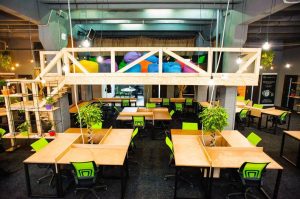Since the pandemic, coworking spaces have seen a significant increase in use. Many factors can explain this, but the most important is hybrid working. These data are precise. Surveys done during the pandemic showed that workers don’t want to return to work full-time. However, they also don’t want to work exclusively from home. Many companies now face the challenge of redesigning their workspaces due to the drastic shift in work habits. Space considerations have changed with employees no longer working five days a week in an office. It is not practical to keep the pre-pandemic layouts of individual offices, as employees have now become hybrid, so the offices are vacant multiple days per week. Coworking spaces are a great way to avoid underutilization of office space.
Under-Utilized Offices
Let’s look at underutilized spaces in greater detail.
HubStar published a blog post last year that showed that 45% of CRE office spaces are unoccupied at any given moment.
Similar results can be seen in a Harvard Business Review article by NikodemSzumilo, an associate professor of economics and finance at University College London, and Thomas Wiegelmann, managing director of Schroder Real Estate Asset Management. They both highlight the enormous impact COVID has had on office occupancy.
The article by Wiegelmann and Szumilo states that office vacancy rates in New York City have increased 11.3% over the past year and are now at their highest level in 27 years. This is true even though New York-based companies like JPMorgan Chase or Goldman Sachs are some of the most vocal about quickly getting workers back to work.
These two astounding statistics will give you an immediate sense of the logic behind why there needs to be a change in how offices are used. Coworking space is one solution.
What’s a Coworking Area?
This leads to the obvious question: What are coworking spaces? DropDesk, a coworking management tool, describes the rise in coworking spaces as follows: “Generally speaking, coworking is when people gather in neutral areas to work independently or in groups on the same projects. Coworking differs from traditional office spaces because coworkers are usually not part of the same company. Coworking spaces provide many of the same amenities as conventional offices but with much more. Flexibility is a critical differentiator in coworking spaces. You can sign a short-term lease.
Gaining Popularity
Coworking Resources is a publication that focuses on coworking space owners. It has published extensive information about the growth of coworking spaces.
Coworking Resources posted an article by Alberto Di Risio entitled “Global Coworking Growth Study 2020,” written by a content contributor.
Allwork reinforces the points made by Di Risio. Space, a digital media company that explores the future of work, shares the following insights in an article .
Today, there are 35,000 flexible workspaces around the globe.
Globally, flexible workspaces are valued at approximately $26 billion
Despite the adverse effects that the COVID-19 pandemic had on the growth of coworking spaces, it is expected that the industry will continue to grow and thrive in a post-pandemic environment.
Coworking Benefits
You might now wonder, “Why would I want my company to move to a coworking model?” Cost savings are often the most important benefit, but let’s remember why other companies have transitioned.
The Exchange is an upscale coworking office and event space located in Mount Pleasant, South Carolina. We are sharing it with you below.
- You have control over the hours
- Networking
- Motivation shared
- No distraction
- Separate identities
- There is no micromanager
- Socializing
A business networking company called The Cannon also wrote a helpful post entitled “The Top 7 Benefits Of Coworking Spaces.”
- Productivity increases
- Network/Collaboration opportunities
- Flexible working schedule
- Private and Shared Office
- To achieve work-life balance, create a structure
- Cost-saving
- Creativity increases
Smart Coworking
Absolute Social, a multi-national information technology company, offers some valuable resources on coworking spaces that use innovative technology. Infosys Associate Vice President and Head of Digital Supply Chain of Sales writes, “Smart Space is an innovative model that caters to increasing demand for shared workplaces by leveraging technology and building and delivering cutting-edge solutions to users working in virtual, physical, and connected environments.
Intelligent spaces and coworking are two sides to the same coin. Innovative spaces are people, processes, and things firmly integrated with technology, like artificial intelligence and the Internet of Things (IoT), to co-exist in flexible workplaces worldwide.
Coworking Space Real Estate
It is essential to ask the following question: What is the impact of CRE on the growth of coworking spaces and coworking?
Andrew Gray, Director and Equity Advisor at Capital Markets, wrote a thoughtful article about this topic for JLL, a global company that provides commercial real estate services. Gray wrote, “Coworking has had an important impact on commercial real estate performance and its utilization.” Coworking operators are responsible for significant positive net absorption in major metropolitan areas.
This is understandable, as the industry was still young ten years ago. Coworking spaces have also led to many “new” businesses that take up space in the same buildings or near the incubators they come from.
Gray continued, “Perhaps the greatest impact on commercial realty landlords is their reliance on coworking operators to withstand any future downturn.” The landlords have made significant investments in the coworking spaces dha, not just the building itself. These spaces are functional and attractive for the end user, but they often look different from what a traditional user would need.


More Stories
Versatile Universal Load Cell for Aircraft Weighing – MODEL: UNV, UNV-C
Why Hiring A Content Writer For Your Website Is A Smart Concept
Brazilian Hardwood Decking: The Ultimate Outdoor Solution